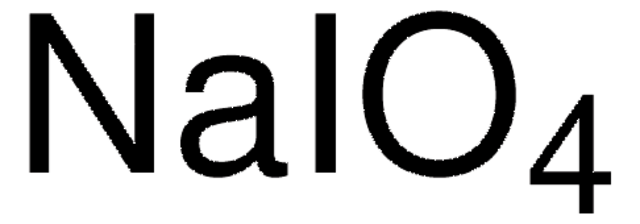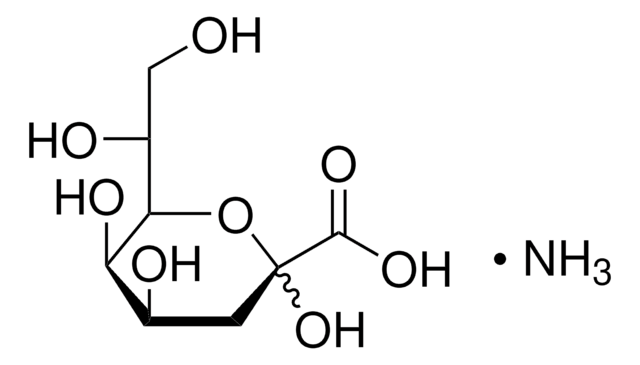311448
Sodium periodate
ACS reagent, ≥99.8%
Synonyme(s) :
Sodium (meta)periodate
About This Item
Produits recommandés
Qualité
ACS reagent
Niveau de qualité
Pureté
≥99.8%
99.8-100.3% dry basis (ACS specification)
Forme
crystalline powder
Pertinence de la réaction
reagent type: oxidant
Impuretés
≤0.02% other halogens (as Cl)
pH
3.5-5.5 (25 °C, 107 g/L)
Pf
300 °C (dec.) (lit.)
Traces de cations
Mn: ≤3 ppm
Température de stockage
room temp
Chaîne SMILES
[Na+].[O-]I(=O)(=O)=O
InChI
1S/HIO4.Na/c2-1(3,4)5;/h(H,2,3,4,5);/q;+1/p-1
Clé InChI
JQWHASGSAFIOCM-UHFFFAOYSA-M
Vous recherchez des produits similaires ? Visite Guide de comparaison des produits
Description générale
Application
- In the selective oxidation of sulfides to sulfoxides.
- For the oxidative cleavage of a variety of 1,2-diols to generate aldehydes or ketones.
- In the oxidation of diaryl, dialkyl, and aryl alkyl selenides to the respective selenoxides.
- In the selective alkene epoxidation and alkane hydroxylation reactions.
- In the selective oxidation of activated cellulose to obtain dialdehyde cellulose (DAC) by cleavage of the bond between C2 – C3 in the glucose unit.
- It can also be used as an iodinating agent for the iodination of arenes and halo compounds.
Mention d'avertissement
Danger
Mentions de danger
Conseils de prudence
Classification des risques
Aquatic Acute 1 - Aquatic Chronic 1 - Eye Dam. 1 - Ox. Sol. 1 - Skin Corr. 1C - STOT RE 1
Organes cibles
Thyroid
Code de la classe de stockage
5.1A - Strongly oxidizing hazardous materials
Classe de danger pour l'eau (WGK)
WGK 3
Point d'éclair (°F)
Not applicable
Point d'éclair (°C)
Not applicable
Certificats d'analyse (COA)
Recherchez un Certificats d'analyse (COA) en saisissant le numéro de lot du produit. Les numéros de lot figurent sur l'étiquette du produit après les mots "Lot" ou "Batch".
Déjà en possession de ce produit ?
Retrouvez la documentation relative aux produits que vous avez récemment achetés dans la Bibliothèque de documents.
Les clients ont également consulté
Notre équipe de scientifiques dispose d'une expérience dans tous les secteurs de la recherche, notamment en sciences de la vie, science des matériaux, synthèse chimique, chromatographie, analyse et dans de nombreux autres domaines..
Contacter notre Service technique











